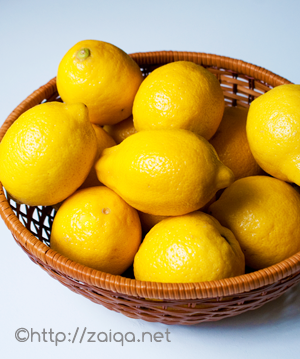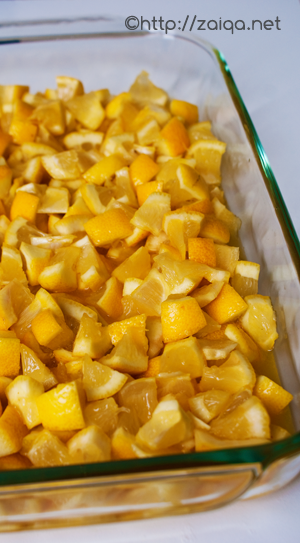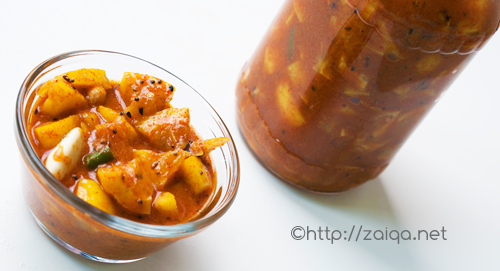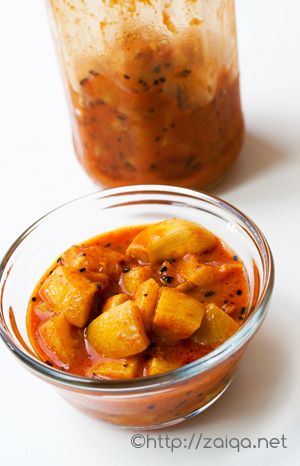Nimbu ka Achaar
Pickles are Indian specialities, enjoyed at breakfasts, at meals, or as an accompaniment to a snack . Each household has their own twist on the pickles that they prepare yearly using freshly available seasonal fruits and vegetables. Among those pickles, mango pickle and lemon or green lime pickle are the two classic indian pickles prepared most commonly in every household, and also easily available at the stores in various varieties.

Fresh Lemons
In todays express lifestyle, the art of making pickles at home is slowly sinking into the mists of time. It only takes a little time, effort and love to prepare these indulgences at home, with your own control on the amount of spices as well as the quality of the product. The following is my mothers recipe for Lemon or Lime pickle.
Note: Pickling is a bacteriostatic method of food preservation, in which the micro-organisms are unable to grow in food. Salt is the main ingredient used as the preservative. Throughout the preperation, take precautions and use only dry spoons for mixing and transfering purpose. Make sure the utensils you are using for making the pickle are absolutely moisture free. Otherwise the pickle will spoil and there are chances of fungus/mould formation. Pickles should never be sored in glazed jars.
Enjoy about a teaspoon of this pickle along with your meals, as an accompaniment to your breakfast or a snack.
Nimbu ka Achaar – Lemon/Lime Pickle
Makes: about 2.5 lb
The procedure includes the following steps which are later described in detail below:
1. Wash and wipe lemons or limes. Chop the 10 lemons or limes, add juice of 2 lemons or limes, mix salt and turmeric and keep aside for 3 days covered in a glass jar with tight lid at room temperature. Shake the bottle gently twice everday so that all the pieces are soaked in the juices.
2. After 3 days, add the powdered pickle spices and the tempering/baghaar to the pickle. Mix well. Transfer to air tight pickle jars and store in the refrigerator for 1 or 2 weeks for the lemon or lime pieces to ferment. The pickle is ready to be used once the skin of the lemons or limes is soft.
Detailed Procedure:
Lemon or Lime – 10, blemish free, ripe and juicy
Juice of fresh lemons or limes
Iodine free Salt – 2 tbsp
Turmeric powder – 1/3 tsp

Cut lemons mixed with turmeric powder, lemon juice and salt in a large glass dish
Choose blemish free, good quality, preferably organic lemons or limes. I am never able to find thin-skinned lemons where I live, so I prepare pickle using thick skinned lemons or green limes, and have kind of got used to them. Infact the thick pickled lemon skin tastes delicious! Wash them and pat them completely dry using a dry cloth. You can also spread them out on a tray and place it under the sun to complately air dry for 1 or 2 hours. If the skin of the lemons you are using is thick (like mine, see the pictures), discard the thick top stalk part and bottom of the lemons and chop up 10 lemons into small quarters and put into a sterilized glass jar with a tight non-metallic lid. This need not be done for limes as they have a thinner skin. Cutting off the top and bottom is also not required if the skin of the lemons you are using is thin. The skin of Indian lemons is usually thin, whereas the lemons that are available elsewhere are quite thick. Discard the seeds. Add salt, turmeric powder and lemon/lime juice to the jar so that all the pieces are covered in the juice and mix well. Keep the jar in a dark place at room temperature for 3 days. Gently shake the jar twice every day.
Red chilli powder – 2 tbsp
Dry Roasted Cumin seed powder – 2 tbsp
Dry Roasted Coriander seed powder -1 tbsp
Dry Roasted Black Mustard seed powder – 1 tsp
Dried Chickpeas/Kabuli Chana – washed and pat dried completely (optional)
Garlic pods – 3
Small green chillies – 4, washed, and completely pat dried, roughly chopped
After 3 days, the lemon/lime pieces will have released a lot of juices. Add and mix all the above ingredients into the chopped lemon/lime quarters with its juices in the glass jar using a dry spoon and keep aside. Now prepare the baghaar or the tempering. (the dried chickpeas and garlic pods turn soft, suitable for eating, upon fermentation and acquire a tangy taste in the pickle).

Freshly prepared Lemon pickle ready to be set aside in the refrigerator to mature
Baghaar or the Tempering:
Canola oil – 1/2 cup
Nigella seeds/Kalonji – 1 tsp
Black mustard seeds – 1 tsp
Cumin seeds – 1 tsp
Dried red chilli – 2
In a pan, heat oil at medium high heat and as soon as it warms up add the remaining ingredients and mix well. In a few seconds they start to splutter. Remove from heat and keep aside. Take care not to burn the spices. Let it cool down and come to room temperature. This is the baghaar or tempering. Once the baghaar is cooled, carefully pour it into the lemon/lime pickle jar.

Lemon pickle ready to be eaten with its skin all nicely softened after 2 months
Store this freshly prepared lemon/lime pickle in the refrigerator to slowly ferment for about a week or two. Fermentation process renders fruits soft and and the fruits take on an additional aroma and flavor of spices. Mould growth is prevented by the use of a tight lid, by which air is prevented from coming in contact. Make sure that you use a completely dry spoon to use the pickle when you feel like eating it, and cover it and store in the refrigerator as soon as possible for a long life. Keep rotating and turning the jar frequently in the refrigerator. Check if the skin of the lemon/lime is soft enough. If you have used thick lemons, you might have to wait a little longer. I kept the pickle jar unopened for 3 months in the refrigerator, before I used it.
Luv,
Mona
You can follow any responses to this entry through the RSS 2.0 feed. You can leave a response, or trackback from your own site.
September 24th, 2009 at 11:04 am
Parcel me that bottle, i will love yo double for that 🙂
Looks so so yumm
Will be a please to share it with you HC, do drop by sometime. ~Mona
September 24th, 2009 at 11:40 am
Please send some my way! Yum!
Sure I will, Zakia bh. ~Mona
September 24th, 2009 at 11:52 am
hey mona
wow. u have the perfect recipe.
my mil prepares a lot of achar these days at my home and mail to her sons. they are just fantastic. she makes so many types and i am really enjoying them
i am not that much into pickles but can u share dhoop nimbu recipe in future. dhoop nimbu and pickles are so tasty during pregnancy.
take care
rizruby
Rizwana, hmmm, Dhoop Nimbu ki yaad dilaadi aapne! Unfortunately there isn’t much of sunshine here for me to prepare Dhoop Nimbu. If you prepare it sometime, do send me the recipe along with pictures so that I can post it on my blog. Really missing it. ~Mona
September 24th, 2009 at 1:14 pm
Lovely Achar Mona…
September 24th, 2009 at 1:25 pm
Woww such a spicy and tempting lemon pickles..just love it with curd rice..
September 24th, 2009 at 5:25 pm
I love love love this achaar! My Mom used to make dhoop neembu and then temper it,I just loved it when mum packed it in my lunch box ,neembu achaar on rotis along with khadi daal, by lunch time, the roti will be soaked in achaar oil and.yummmmmmmmmmmmmm
Syeda, I really miss Dhoop Nimbu. Inshallah will definitely have it when I visit Hyderabad. Do post the recipe for Dhoop Nimbu on your blog when you prepare it.
Nimbu achaar with Khadi dal and Roti sounds deeeelish! ~Mona
September 24th, 2009 at 9:13 pm
Mona, did you keep your pickle for 3 months?? OMG, pickle look so tempting. 🙂 I remember my Mom used to make all types of achaar at home only. Though, I always end up with store bought one. 🙁
My hubby loves Nimboo achaar…but keep it in fridge about couple of months…I can’t wait. Let me try with small batch. Your pics are so neat and beautiful. Thanks for recipe.:)
Sonu, I kept the pickle untouched in the refrigerator before use for 3 months because I wanted the thick skin of the lemons to nicely soften up completely and absorb all the flavors. ~Mona
September 25th, 2009 at 11:53 am
salaamz mona jee i am so happy to see this recipie……… i love it thanks……….can you send how to make dhoop nimbuu.
Nishat, sunshine is not very strong here in Ontario where I live, so I cannot prepare Dhoop Nimbu. Inshallah when I visit some warmer places I will post the recipe. ~Mona
September 26th, 2009 at 7:19 am
AOA
MUJEH ES AACHAR KI TARQEEB CHIYAI THI. BOHOT SHUKRIYA MOONA JI.MEH KARACHI PAKISTAN SAI HOON.
September 28th, 2009 at 1:57 pm
It is interesting to know that in India pickles are eaten for breakfast too. In Azerbaijan, we eat them as an accompaniment to main dishes, to nibble at in between the bites:) Your recipe sounds delicious!
Farida, yes, we enjoy pickles as an accompaniment to Upma, Khichdi, etc which are usually eaten at breakfasts. ~Mona
September 28th, 2009 at 2:10 pm
mona, could you post the recipe for Bagara Annam? thanks.
Sri, I will post it in a couple of days. ~Mona
September 29th, 2009 at 1:26 am
Teet ka achar banane ka trika chahiye
Gautam, I do not understand what do you mean by ‘teet’, please explain. ~Mona
September 29th, 2009 at 2:56 pm
Mona the achaar looks sooooo tempting , thanks for sharing the recipe
September 30th, 2009 at 10:22 am
Lovely achar Mona. Drooling!
September 30th, 2009 at 11:50 am
monajee, excellent work and photogrphi. monajee in case of sweet lemon pickle to be make- how to proceed? will you pls expalin it? thanks
Shaikhmohammed, this is the only pickle I make using lemons. ~Mona
October 6th, 2009 at 10:33 am
Mona,
My mom also makes all kinds of achar. I have soaked nimbus sitting in the fridge. Now I am going to try ur recipy. It sounds so simple, hope the color turns out as brgt as the one u hav made.
Thanks for posting such mouth wtring recipies. I get inspration to cook.
Lubna, Inshallah the achaar will turn out good. Just make sure you follow all steps carefully and take necessary precautions.
Also, I am curious to know what do you mean by ‘I have soaked nimbus sitting in the fridge’. I apologize I did not get you there.
Feel free to share with me your Mom’s recipes. ~Mona
October 18th, 2009 at 9:50 am
Dear Mona,
Since my computer was down for many days I saw ur request today only. I will be adding this lemon pickle in the round-up for Think Spice – Think Red Chillies. Please link this post back to the event announcement in my blog.
BTW – Lemon Pickle looks very good and lipsmacking.
July 23rd, 2010 at 5:27 pm
Asam mona, i did try this achaar recipe and after 3 months its time to relish it now…..but at the looks of it,it looks to dry…. i followed ur recipe word by word….was just wondering if i need to add some more oil …if i do, then do i need to add hot or cold oil to it……pls do let me know….waiting for ur reply.
WaAlaiKumAsSalaam Jabeen, perhaps the lemons you used were not juicy enough. Anyways what you can do now is prepare a baghaar again in 1/2 cup oil and let it cool. Once cool pour the baghaar into the pickle and store the pickle in the refrigerator. Try to finish the pickle as soon as possible.
October 13th, 2010 at 6:04 am
Mona I have just kept the lemons in dark. This is my first experience of any achaar!plz tell me that the chickpeas u mentioned were roasted or not?
Humaira, you have to use kabuli chana or dried chickpeas.
November 28th, 2010 at 1:04 pm
Dear Mona,
I am new to your blog but really enjoy it and look forward to each new recipe. I made your Kachey Gosht ki Biryani this last Eid and it turned out really well.
Mona, I am looking for a nimbu achaar recipe and decided to check your blog and am really interested in trying the one above. However, I will be using small thin-skinned lemons, the size of the average desi lemon in India and Pakistan. Could you tell me how many I will need for this recipe?
Amber, you will need the same number of lemons even if you are using thin skinned lemons.
January 7th, 2016 at 8:19 am
Assalamualaikum, I’ve tried your Gosht achaar and must say it turned out very tasty..next i want to try this recipe but have some few questions..pls guide me:1) can u state the amt of chickpeas i need to use? 2)Here in hyd we get small sized lemons so shall i use twenty of those as you have used ten which might be double in size to the ones i get here.Or maybe a weight measurement suggested by you would be appreciated.3)I have iodised salt at home, can i use coarse sea salt instead or what should i use as replacement. Jazakallah and your blog has amazing recipes Mashallah!